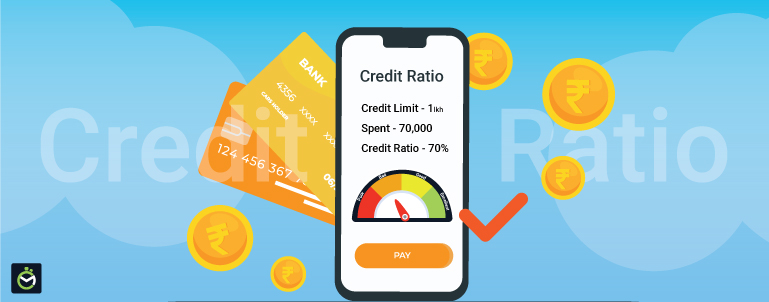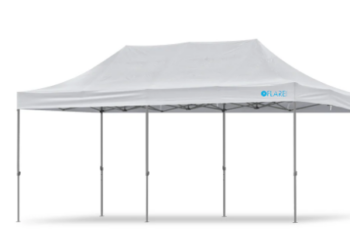To build a healthy credit score, you need to focus on several factors like paying your bills on time, lowering your credit utilisation ratio and more. In this article, we take a look at the role played by credit utilisation ratio in determining your credit score.
A large credit utilisation ratio is detrimental to your credit score. We share smart strategies to help you bring down this critical ratio and improve your credit profile.
What’s in here?
- What is the credit utilisation ratio?
- Why does it matter?
- Tips to lower the credit utilisation ratio
What is the credit utilisation ratio?
The credit utilisation ratio is a measure of the credit you owe to the total available credit limit. Let’s explain that with an example. For instance, let’s assume you have a credit limit of Rs. 1 lakh on your credit card, and if you’ve spent Rs. 70,000 on it, then your credit utilisation ratio is at 70%. That’s a high ratio and is not favourable for your credit score.
Why does it matter?
When you have a high credit utilisation ratio, it means you’re typically over-relying on credit. It shows that you’re overspending on your credit cards, which in turn, classifies you as a risky borrower, who is likely to delay or default payments. Lenders generally prefer borrowers with low credit utilisation ratios. Borrowers with high credit utilisation ratios are classified as overextended, and lenders consider that they will have difficulty repaying their debts.
The general rule of thumb is to aim for a credit utilisation rate of 30% or lower. Going over this number may cause your credit scores to drop, lowering your eligibility for loans and increasing loan interest rates. You need to keep the credit utilisation ratio below 30% on each credit card and your overall credit limits.
Different credit bureaus factor credit utilisation ratio differently in their algorithms while calculating credit scores. For example, in Equifax and Experian credit scores, credit utilisation ratios account for 30% of the overall score.
The bottom line is that the credit utilisation ratio plays a crucial role in determining your credit score. You should aim to keep it below 30%.
Strategies to Lower your Credit Utilisation Ratio
These tips can help you keep your credit utilisation ratio low.
- Keep Track of Credit Card Spends
Very often, we come across well-intentioned advice like, “avoid using your credit card to lower your credit utilisation ratio.” However, this is not the right approach. Using your credit card regularly and responsibly plays a crucial role in improving your overall credit score.
The smart approach here is to NOT AVOID using your credit card but to use it smartly.
The simplest and easiest way to keep your utilisation ratio low is to watch how much you spend on each credit card. Inculcate the habit of checking credit card spends regularly. If you notice that you’re going beyond the 30% credit limit, then you can switch your spending to another credit/debit card. Alternatively, you can make a payment on the card before the due date to restore your credit limit.
- Request for an Increase in Credit Card Limit
This is the best way to lower your credit utilisation ratio, but it may not always be possible. When you ask for an increase in your credit limit, your credit utilisation ratio goes down. For example, let’s state that you have a credit limit of Rs. 1 lakh and spend Rs. 40,000 on it. Your ratio, in this case, is 40%.
Now, let’s assume that you ask your bank to increase your credit card limit to Rs. 1.5 lakhs, and the request is approved. You spend the same Rs. 40,000 on your card. In this case, your ratio is 26%, which is well below the golden 30%.
To request an increase in credit limit, you can visit your card issuing bank in person or apply online. However, note that the approval is solely at the lender’s discretion, and you may or may not be approved.
A pivotal point to keep in mind is that asking for an increase in credit limit leads to a hard inquiry, which temporarily brings down your credit score. Once the limit is sanctioned and you pay your credit card bills on time, the credit scores bounce back.
- Apply for a New Credit Card
Instead of requesting your bank to increase the credit limit on an existing card, you can apply for a new credit card to improve your overall available credit limit. Here’s an example to explain this. Let’s assume that you have a credit card with a limit of Rs. 50,000 and you spend Rs. 25,000 on it regularly. Your credit utilisation ratio is high, at 50%.
You can apply for a new credit card. Let’s assume that you get another credit card with a credit limit of Rs. 40,000. Now, your overall credit limit is Rs. 90,000, and you spend Rs. 25,000 together across both cards. Your utilisation ratio now drops to 27%, even though your expenses on your credit cards remain the same.
Again, remember that getting a new credit card leads to a hard inquiry, which temporarily drops your credit score.
A word of caution: Avoid increasing your expenditures just because you have a bigger credit limit or two cards. This defeats the purpose and keeps your utilisation ratio high. To lower your utilisation ratio, you need to limit or maintain your expenses, irrespective of the increase in credit limit.
- Do NOT Close Old/Unused Credit Card
Closing old/unused credit cards lowers your available credit limit, thereby increasing your utilisation ratio. Keeping your old credit cards open, even though you don’t use them, is beneficial for your credit score in several ways. It not only helps to lower your utilisation ratio but also lengthens your credit history, which in turn improves your credit score.
- Pay Credit Card Bills on Time & In-full
The more outstanding balance on your credit card, the higher will be your utilisation ratio. So, if you have a habit of just paying the minimum balance on your credit card bill, abandon this practice.
If you have racked significant outstanding balances on your credit cards, try to close them all to release available credit limits. Suppose you’re having difficulty raising funds to settle all outstanding credit card balances. In that case, you can even consider taking a personal loan to pay credit card dues.
Once you have paid all credit card dues, it may take a couple of months for effect to be visible on your credit scores. Till then, avoid large spends on your credit cards to keep your utilisation ratios low.
- Pay Credit Card Bills more than Once a Month
Generally, banks/credit card issuing agencies report card balances to credit bureaus monthly. However, this date may not coincide with your billing date. For instance, if your bank reports a week before your credit card bill date, then your utilisation ratio may be high, even though you settle all your bills on time.
It’s highly recommended that you settle outstanding credit balances more than once a month to avoid this. This way, your available credit limit is high, bringing down the utilisation rate.
Final Thoughts
Having a low credit utilisation ratio is an excellent method to maintain and boost your credit scores. Having high credit scores offers several benefits for your financial health. It improves loan eligibility, increases loan sanction, credit card approvals while giving you leverage in negotiating loan interest rates.
Use the strategies listed here to bring down credit utilisation rates and boost your credit score.






